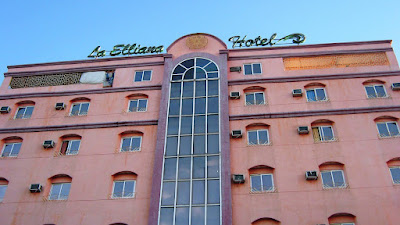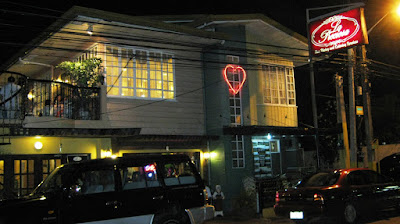
(St. Theresa of The Child Jesus)
PLEASE PICK FOR ME A ROSE FROM THE HEAVENLY GARDENS
AND SEND IT TO ME AS A MESSAGE OF LOVE.
O LITTLE FLOWER OF JESUS,
ASK GOD TODAY TO GRANT THE FAVORS I NOW PLACE
WITH CONFIDENT IN THY HANDS.. (Mention yr request)
ST. THERESA,
HELP ME TO ALWAYS BELIEVE AS THOU DIDST IN
GOD GREAT LOVE FOR ME
SO THAT I MIGHT IMITIATE THY LITTLE WAY EACH DAY.
AMEN.
5x OUR FATHERS
5x HAIL MARYS
5x GLORY BES
Pray 5 consecutive days before 11.00 am. Ask for *sign (sign in a form of a rose, you can request from St Theresa specific colour of rose) if you saw rose that’s mean she heard your prayer and working on it.
* Any form of roses – real flower, picture, statue, smell of rose etc.
St. Therese loved nature, and often used the imagery of nature to explain how the Divine Presence is everywhere, and how everything is connected in God's loving care and arms. Therese saw herself as "the Little Flower of Jesus" because she was just like the simple wild flowers in forests and fields, unnoticed by the greater population, yet growing and giving glory to God. Therese did not see herself as a brilliant rose or an elegant lily, by simply as a small wild flower. This is how she understood herself before the Lord - simple and hidden, but blooming where God had planted her.
Therese believed passionately that Jesus was delighted in his "little flower", and just as a child can be fascinated by the grandeur of a simple flower, she believed that Jesus was fascinated by her as his "little flower". Therese understood that she was just like the tiny flower in the forest, surviving and flourishing through all the seasons of the year. Because of God's grace, she knew that she was stronger than she looked. Following the Carmelite tradition, Therese saw the world as God's garden, and each person being a different kind of flower, enhancing the variety and beauty which Jesus delighted in. When various people tried to explain her powerful inspiration and her place within the Church, it always seemed to come back to one title "The Little Flower".
In her autobiography, she beautifully explains this spirituality:
Jesus set before me the book of nature. I understand how all the flowers God has created are beautiful, how the splendor of the rose and the whiteness of the lily do not take away the perfume of the violet or the delightful simplicity of the daisy. I understand that if all flowers wanted to be roses, nature would lose her springtime beauty, and the fields would no longer be decked out with little wild flowers. So it is in the world of souls, Jesus' garden. He has created smaller ones and those must be content to be daisies or violets destined to give joy to God's glances when He looks down at His feet. Perfection consists in doing His will, in being what He wills us to be.
When is her Feast Day?
The Roman Catholic Church celebrates the feast of St. Therese, the Little Flower, on October 1st each year. This date was chosen because Therese died on September 30th. Following the ancient custom of celebrating their entrance into heaven the next day, October 1st was chosen as the day to celebrate Therese's life and eternity. Some people may remember that her Feast Day was previously October 3rd. That date was established for several reasons, including a packed liturgical calendar. In the liturgical renewal of the 1970's, when the calendar of saints was updated and refined, St. Therese's feast was properly moved to the more appropriate October 1st date. It is interesting to note that St. Therese's home Church in France celebrates her Feast Day on the last Saturday of September, no matter what the date.
How did she get the name "Therese of the Child Jesus and the Holy Face"?
Following the biblical tradition, when people entered religious life, they took a new name to signify their new call from God. When she entered the Carmelite Monastery to give her life to God, Marie Francoise Therese Martin took the religious name "Therese of the Child Jesus and the Holy Face." Therese had great devotion to the Infant Jesus, and her spirituality was a childlike simplicity and trust in God's love. In Lisieux, the Carmelite Monastery had a great devotion to the suffering Holy Face of Jesus that was reflected on the veil of Veronica. This included an outdoor shrine in the cloister garden. Because Therese was constantly looking to see the hidden Holy Face of Jesus in everyone and everything, Therese took that second part of her religious name. She explained: "I desire that, like the Face of Jesus, my face be truly hidden that no one on earth would know me. I thirsted after suffering and I longed to be forgotten." Her religious name, Sr. Therese of the Child Jesus and Holy Face, therefore came to signify what she was about and how God's grace was working in her.
What are the four miracles that made Therese a Saint?
Therese became a saint because of the way she responded wholeheartedly to God's love and the grace of the Holy Spirit within her. We believe that God embraced her upon her death and shared with her a risen life of Jesus in heaven. While the Church recognizes the holiness and sanctity of many good people, official canonization is a long process. The Roman Catholic Church seeks definite signs before she officially declares someone a saint. In the case of St. Therese, the process went swiftly. In the popular piety of the people, she became a saint in their hearts even before the official declaration. A person is declared "Venerable" when there is evidence of extra-ordinary holiness and inspiration for others. It means that the cause of their canonization is being pursued. In order to move to the next step "Beatification", two certified miracles are needed, attributed to the intercession of that person with God in heaven. Miracles must involve situations where there is no other natural explanation. They are evidence of supernatural intervention, through intercessionary help.
Regarding St. Therese, in 1923 the Church approved of two spontaneous cures unexplained by medical treatment. Sister Louise of St. Germain was cured of the stomach ulcers she had between 1913 and 1916. The second cure involved Charles Anne, a 23 year old seminarian who was dying from advanced pulmonary tuberculosis. The night he thought he was dying, Charles prayed to Therese. Afterward, the examining doctor testified, "The destroyed and ravaged lungs had been replaced by new lungs, carrying out their normal functions and about to revive the entire organism. A slight emaciation persists, which will disappear within a few days under a regularly assimilated diet." These two miracles resulted in Therese becoming beatified.
Once she was declared Blessed, it took only two years for the necessary next two miracles to be approved. In 1925, two cures had been investigated and judged to be supernatural, through the intercession of St. Therese. The first involved Gabrielle Trimusi from Parma, Italy. Gabrielle had suffered from arthritis of the knee and tubercular lesions on the vertebrae. The final cure involved Maria Pellemans of Schaerbeck, Belgium. Maria suffered from pulmonary tuberculosis which had spread, as Therese's illness had, to the intestines. The diagnosis of pulmonary and intestinal tuberculosis was made by a Dr. Vandensteene, who also examined Maria after she came back from visiting Therese's grave. The doctor testified, "I found Miss Pellemans literally transformed. This young woman, out of breath from the least movement, moves about without fatigue; she eats everything given to her, with a very good appetite. The abdomen presents no tender point, when formerly the least pressure produced severe pain. All symptoms of tubercular ulceration of the intestine have disappeared." In reports predating Maria's return to health, two other physicians confirmed Dr. Vandensteen's diagnosis of pulmonary and intestinal tuberculosis. On May 17, 1925, Therese was officially declared a Saint by Pope Pius XI.
Is there a Novena I can pray to St. Therese?
The most loved and repeated novena to St. Therese is the "Miraculous Invocation to St. Therese" found on the St. Therese prayer card. It is as follows:
O Glorious St. Therese, whom Almighty God has raised up to aid and inspire the human family, I implore your Miraculous Intercession. You are so powerful in obtaining every need of body and spirit from the Heart of God. Holy Mother Church proclaims you 'Prodigy of Miracles... the Greatest Saint of Modern Times.' Now I fervently beseech you to answer my petition (mention here) and to carry out your promises of spending Heaven doing good on earth...of letting fall from Heaven a Shower of Roses. Little Flower, give me your childlike faith, to see the Face of God in the people and experiences of my life, and to love God with full confidence. St. Therese, my Carmelite Sister, I will fulfill your plea 'to be made known everywhere' and I will continue to lead others to Jesus through you. Amen.
There is also a "Novena Rose Prayer" on the back of the prayer card that is also very popular and said by many. The Society will be happy to give you a prayer card. Simply visit our Web site at /welcome/freegift.asp, or send us your postal address via e-mail. If you would like more for sharing with family, friends, neighbors, etc. they can be ordered the same way or through our Religious Items Page.
A novena prayer is usually nine days. These prayers are powerful. Sometimes, just a long personal talk with St. Therese, in your own words and from your heart, is just as powerful. Therese proposes and used a very simple spirituality. While some people have proposed that certain prayers must be said at certain times and before certain hours, and connected with other prayers, this is not Therese's "little way". She took seriously Jesus' request that we not use lots of words, but rather pray to God our Father in simple, hidden and honest ways. Because a certain formula, place or time works for someone, it should not be canonized as the way to pray. Some people do a real disservice to Therese and her devoted friends by surrounding her and devotion to Therese with superstition. It is not important or even significant that a certain novena prayer be said before a certain hour or in conjunction with other prayers. This is nothing but superstition, not piety, as are chain letters, etc., which seem to be popular.
Pray to our saintly friend St. Therese with the honesty and love of a friend and the simplicity of a child. This is what she taught us. These novena prayers are very helpful and express the devotion of many hearts.
What is meant by her "little way"?
Therese saw herself as a child of God. She liked to keep things simple and focused as a child does. Trust, especially trust in God, is a childlike virtue. Some spiritualities have stressed complicated practices and extraordinary journeys of the soul as it responds to God's grace and love. Therese's spirituality is simple and she calls it her "little way". She believed and teaches us that life presents enough challenges and opportunities for grace. She teaches us that God is everywhere - in every situation and person - and in the ordinary, simple details of life.
"Everything is grace" is probably the theme song of her spirituality. Her "Little Way" teaches us to do the ordinary things of life with extraordinary love. A smile, a note of encouragement, a phone call, suffering in silence, always having a positive word, a simple unnoticed task to brighten the life of another, and so many other simple deeds, done with love - these are the examples of her spirituality. The smallest action, done with love, is more important than great deeds done for personal glory, gratification or simply out of obedience. Therese teaches us that Jesus is everywhere and is the power for love and goodness operating within us. Such is the power and presence of grace. Therese's life was hidden. To many even in the convent, she seemed like such an average, ordinary person. Her greatness showed in the constancy of her love for others in the most simple ways.
Even in prayer, Therese teaches simplicity - talking to God and Jesus in direct, personal and heartfelt ways. She did not like long prayers. She fell asleep during community prayer. She disliked the rosary. She prayed from her heart as a child speaks honestly and trustingly to a parent they love. God calls us to respond to Divine Love in a childlike relationship of love, trust and bold confidence to "Abba" (which literally means 'Dad'), and by doing the simple things for others, well and with love.
Therese was faithful to the Gospel of Jesus and the core of his message. She invites us to join in her "spiritual childhood" or "little way". The power, appeal and simplicity of her message is why our Church declared her a Doctor of the Church in 1997.
What did she mean by her "Shower of Roses"
Experience has shown that St. Therese's "shower of roses" is both figurative and actual. As she was dying in the convent infirmary, Therese could look out and see the rose bushes blossoming. She loved roses. She had thrown rose petals as a Child before the Blessed Sacrament. As she reflected on her quiet, hidden, and gentle life ending, she believed in faith that God had great things in store for her. She believed that her mission was only beginning as she entered the fullness of life with God. She explained: "After my death, I will let fall a shower of roses. I will spend my heaven doing good upon earth. I will raise up a mighty host of little saints. My mission is to make God loved..."
Shortly after her death, the rain of roses began. Sometimes roses literally appeared, and sometimes just the fragrance of them. Cures of painful and fatal diseases and many other miraculous experiences were attributed to her intercession. Sometimes people found inner peace and regained an inner warmth of spirit and confidence, by appealing to St. Therese. Many miracles and actions of St. Therese do not involve roses. More often than not, marvelous things happen in people's lives as they ask for her heavenly intercession. The miracles, healings and inner peace come from the trust one places in God, not from any manifestation of roses. St. Therese lived in the dark night of the senses and spirit, with little consolation. Thus, the friends and followers of St. Therese expect no consolation of sighted roses that their prayers are being answered. Her "little way" is about child-like trust and gentle love. She is the great apostle of faith in God's love, not simple reliance on physical signs. Jesus warned us, and Therese experienced that the desire for signs is a sign of weak faith. It is always important to remember that St. Therese did not experience extra-ordinary phenomena in her life. Her faith was refined and strengthened by God.
Roses are Therese's signature. It is her way of whispering to those who need a sign that she has heard, and God is responding. Thousands of people have given witness to the way Therese responds to their petitions and prayers with grace and roses. The grace is more important than the roses. So many miracles have happened through the intercession of St. Therese without any roses appearing - usually the deep inner peace of accepting God's will and seeing His loving plan and presence is the "rose" experienced. Sometimes the lack of a physical "rose signature" is an affirmation of a strong faith.
One does not pray for roses. Therese's message is about simplicity and love in the ordinary events of life. Trust in Therese is important, and when she wills, roses or their fragrance may appear. The stories are remarkable how roses have shown up in the lives and experiences of people, especially in the darkest times. The ordinary and constant way these roses and graces have shown up in people's experience is extraordinary. It is important to always maintain the rose of confidence that our All-Loving God hears and responds to our needs, according to the mysterious ways of His Love.
Why is her name sometimes spelled "Therese", "Theresa", and "Therese"?
All three are appropriate, but if one is to remain faithful to her actual French name, it is "Therese". In English, we don't have the vowel marks which the French have, so she is simply "Therese". It became popular to use the more Anglicized version "Theresa", but more recently it has caused confusion between her and Teresa of Avila. In order to avoid confusion between the two Carmelites, many choose to use the spelling more reflective of her French name, "Therese". We believe she answers to all of them.
How far is it from Paris to Lisieux, and should I consider making the trip?
By all means, if you are in Paris, get to Lisieux. Lisieux is a small town in Normandy, about 80 miles outside Paris. It is becoming one of the premier pilgrimage places in the world, currently receiving more than two million pilgrims a year, and the number continues to grow. It is a quick hour and a half train ride from Paris. The city is well established for receiving pilgrims, with a number of places related to the life of St.Therese. There you can visit her house "Les Buissonnets", the magnificent Basilica in her honor, her parish Church, and the Carmelite Convent. There is a small wonderful museum of her memorabilia. It is easy to get around and see everything in one day. Just walking around the town makes her come more alive. The Carmelite Nuns of Lisieux must protect the privacy of their life, so one cannot get into the Carmel cloister, but the Church is there and you can see the chapel where Therese prayed, her seat marked with a cross.



































